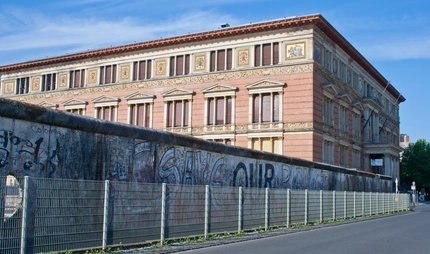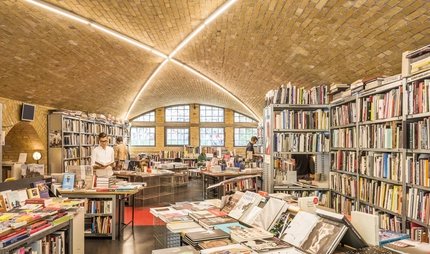
Throughout Berlin you will find fascinating buildings, examples of Berlin Modernism from the Bauhaus to the present day. Master architects like Gropius, Taut and Mies van der Rohe have built all over the city: Housing estates and office buildings, but also lidos and airports.
11 + 1 Tips for exciting places we present to you, one in each Berlin district. Go on a discovery tour and find out what Berlin's modern age is all about. You'll find even more about Berlin Modernism and interesting information at visitBerlin.de.
Tip 1: Mies van der Rohe Haus
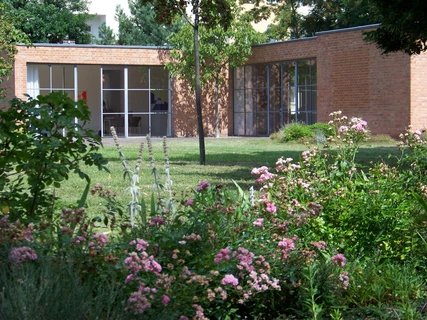
Small but nice. The Mies van der Rohe Haus in Alt-Hohenschönhausen is a little bit the little sister of the famous Neue Nationalgalerie in Berlin and a jewel in the green. The simple, elegant villa designed by Mies van der Rohe for the factory owner Lemke has become a popular exhibition space for art and architectural themes. Ideal for a day trip, because you can make a detour to the nearby Obersee immediately afterwards.
Where: Oberseestraße 60, Lichtenberg
When: Tuesday - Sunday 11am - 5pm
More information about Mies van der Rohe Haus
Tip 2: Shell building

One of the most beautiful and architecturally interesting buildings in Berlin is the Shell House on the Landwehr Canal. Gently curved and with its unique wave form, it looks different from every side. Built between 1930 and 1932 by Emil Fahrenkamp, the building is one of Berlin's first buildings with a steel skeleton construction. Tip: If the house approaches from the right side, it shows its chocolate side.
By the way: The Bauhaus Archive is very close by and is currently being rebuilt, so it is unfortunately closed.
Where: Reichpietschufer 60-62, Mitte
When: Not open to the public
More information about the Shell-Haus
Tip 3: Gartenstadt Falkenberg
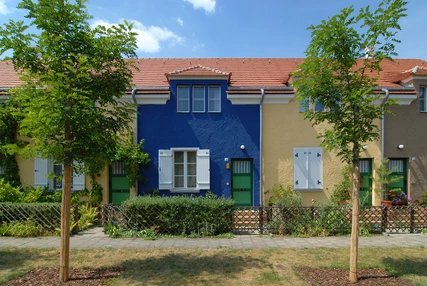
Do you fancy colourful house facades like in Portugal? Then have a look at the garden city Falkenberg in Treptow-Köpenick! The colourful settlement is also known as the inkbox settlement and is a UNESCO World Heritage Site. The creator of this wonderful play of colours is the architect Bruno Taut, who broke conventions with his colour design. With his residential complex, based on English models, he created affordable living space in the countryside for everyone.
Where: Akazienhof, Am Falkenberg, Gartenstadtweg, Treptow-Köpenick When: The Gartenstadt Falkenberg is a residential area.
More information about Gartenstadt Falkenberg
Tip 4: Haus des Deutschen Metallarbeiterverbandes

A house and its message. When you stand in front of the house of the German Metalworkers Association, pay attention to the curved shapes and the flagpole in the middle of the front. Erich Mendelsohn builds the house as the union's headquarters, and so it resembles a demonstrator with the flag in his hand. The house was not only radically modern in design, but also equipped to a high standard. Inside, it is the beautifully designed lamps and elegant stairwells with brass cladding that make it so special. After serving as the seat of the National Socialist German Labor Front during National Socialism, today it is once again a trade union building - with the flag in its hand.
Where: Alte Jakobstraße 148, Friedrichshain-Kreuzberg
When: The building is an office building, seat of IG Metall
More informationabout the Haus des Deutschen Metallarbeiterverbandes
Tip 5:Großsiedlung Siemensstadt
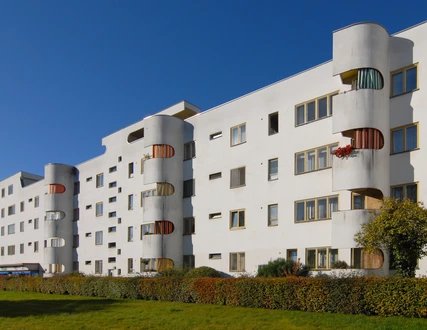
Licht und Luft statt übelriechender Hinterhöfe und dunkler Wohnungen –das ist die Maxime der Architekten für die neue Arbeitersiedlung. Gleich sechs Architekten haben die Siedlung entworfen – und so könnt ihr ganz unterschiedliche Stile bewundern. Hans Scharouns Gebäude am Eingang ähnelt einem großen Schiff, ganz schlich und funktional hingegen ist die Bauweise von Walter Gropius. Otto Bartnings Gebäuderiegel ist dann auch so schlicht geraten, dass er den Beinamen „Langer Jammer“ erhält. Mehr über die Siedlung, die zum UNESCO-Welterbe gehört, erfahrt ihr in der Infostation Siemenssstadt.
Wann: Infostation Samstag: 13 - 17 Uhr
Where: Siemensdamm, Charlottenburg-Wilmersdorf
More information about Großsiedlung Siemensstadt
Tip 6: Hufeisensiedlung
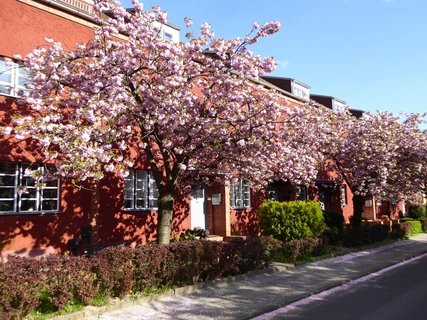
For a village feeling in the middle of the big city. Bruno Taut also designed the Hufeisensiedlung in Berlin Britz. The horseshoe-shaped settlement has resident gardens and plenty of space. If you walk through the tranquil streets, you might think you're in the village - and that's also typical of Berlin. This settlement has also been included in the Unesco World Heritage since 2008.
Where: Fritz-Reuter Allee, Neukölln When: The Hufeisensiedlungt is a residential area.
More information about Hufeisensiedlung
Tip 7: Lido at Wannsee

Das Strandbad Wannsee ist eines der größten Freibäder an einem Binnengewässer in Europa. Es befindet sich am Ostufer des Großen Wannsees, eines Havel-Ausläufers in Berlin. Das heutige Strandbad Wannsee basiert auf den Planungen des Architekten Martin Wagner, der 1915 ein erstes Bebauungskonzept für die bis dahin noch kaum erschlossene Badestelle am Ufer des Großen Wannsees erarbeitete und 1927 schließlich ein modernes „Weltstadtbad“ im Sinne der Neuen Sachlichkeit konzipierte. Der denkmalgeschützte Gebäudekomplex mit einer Länge von 540 Metern wurde von 1929 bis 1930 nach Entwürfen des
Every Berliner knows the lido Strandbad Wannsee - less because of the architecture of the complex than because of the bathing pleasure in summer. Nevertheless, before jumping into the water, it is worth taking a look at the complex, which was built in the early 1930s in the style of the New Objectivity. Designed as a modern cosmopolitan swimming pool, the building was supposed to be 1 km long. It is too modern for the Nazis, they prevent the further construction. So today only half of the originally planned building stands - but that is impressive enough.
Where: Wannsee lido, Wannseebadweg 25, Steglitz-Zehlendorf
When: Open at the beginning of the outdoor swimming pool season
More information about lido Wannsee
Tip 8: Wohnstadt Carl Legien
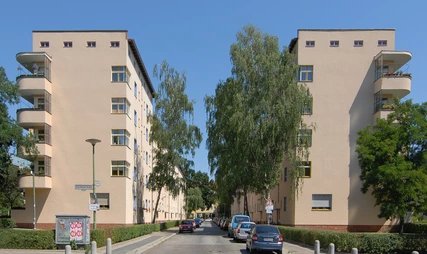
Affordable living and also light, air and sun? A classic case for Bruno Taut!
In the residential area Wohnstadt Carl Legien in Prenzlauer Berg, you get the feeling of space in the middle of the big city when you enter. All apartments have either a balcony or a large loggia, the inner courtyards are huge green gardens. True to Tauts motto "colour is joie de vivre", window frames and staircases are also designed in different colours.
Where: Erich-Weinert-Strasse, Pankow When: Wohnstadt Carl Legien is a residential district.
More information about Wohnstadt Carl Legien
Tip 9: Weiße Stadt

The opposite of the ink box settlement! There are no colourful facades here: The White City rightly bears its name. To save costs, the elements such as doors, windows and stairwells are uniformly designed - and the plaster is uniformly white. Only the window and door frames in bright colours set colourful accents. But this is precisely what makes the system so attractive, as it is a UNESCO World Heritage Site.
Where: Aroser Allee, Emmentaler Straße, Genfer Straße, Reinickendorf
When: The White City is a residential area.
More information about the Weiße Stadt
Tip 10: Airport Tempelhof

Der Flughafen Berlin-Tempelhof war einer der ersten Verkehrsflughäfen Deutschlands und nahm 1923 den Linienverkehr auf. Er war bis zu seiner Schließung am 30. Oktober 2008 neben Berlin-Tegel und Berlin-Schönefeld einer von drei internationalen Verkehrsflughäfen im Großraum Berlin und trug die Bezeichnung Zentralflughafen. Im Jahr 2007 wurden dort rund 350.000 Fluggäste abgefertigt. Seit 2010 wird das ehemalige Flughafengelände vom Land Berlin und seinen Unternehmen mit dem Projektnamen Tempelhofer Freiheit bezeichnet und ist für die Öffentlichkeit als grüner Erholungsort zugänglich. In den
The former airfield at Tempelhof Airport is one of the favourite destinations for Berliners at the weekend. Today, the site is the largest architectural monument in Europe with an eventful history. Begun in the 1920s, the Nazis created its present form, which wants to make it the largest air cross in the world. During Berlin's blockade, the airport was the gateway to the world. It was closed in 2008 and has been used as a huge park ever since.
Where: Tempelhofer Damm 1-7 , Schöneberg-Tempelhof When:The field is open every day until dusk, a guided tour of the airport buildings is possible.
More information about airport Tempelhof
Tip 11: Ahrensfelder Terrassen
The Ahrensfeld Terrassen in the green diestridt Marzahn are a housing estate with spacious roof terraces that have also given the complex its name. Former prefabricated buildings have been rebuilt for this purpose. Like the facades, the large balconies are designed in warm colours. Originally, the prefabricated building complex was to be demolished. But the residents were strong against it, and so a generous housing complex was created: Today everything is completely rented out!
Where: Märkische Allee / corner Havemannstraße, Marzahn-Hellersdorf When: The Ahrensfelder Terrassen are a residential area.
More information about Ahrensfelder Terrassen
Tip 11+1: Flachbausiedlung Staaken

Die Siedlung Neu-Jerusalem ist eine seit 1992 denkmalgeschützte Wohnanlage des Neuen Bauens an der Heerstraße im Berliner Ortsteil Staaken (Bezirk Spandau), nahe der Berliner Stadtgrenze. Die Siedlung wurde 1923/1924 von dem Architekten Erwin Anton Gutkind geplant und 1925 fertiggestellt.
Less well known than the large housing estates of the Berliner Modernism, but still worth a visit is the housing estate Staaken on Heerstraße. This jewel of modern architecture was built in the early 1920s as one of the first new-style housing estates with 21 semi-detached houses and a show house. And perhaps you will also find out during a visit why the settlement bears the beautiful epithet New-Jesusalem.
Where: Heerstraße, Spandau
When: The Flachbausiedlung Staaken is a residential area.

